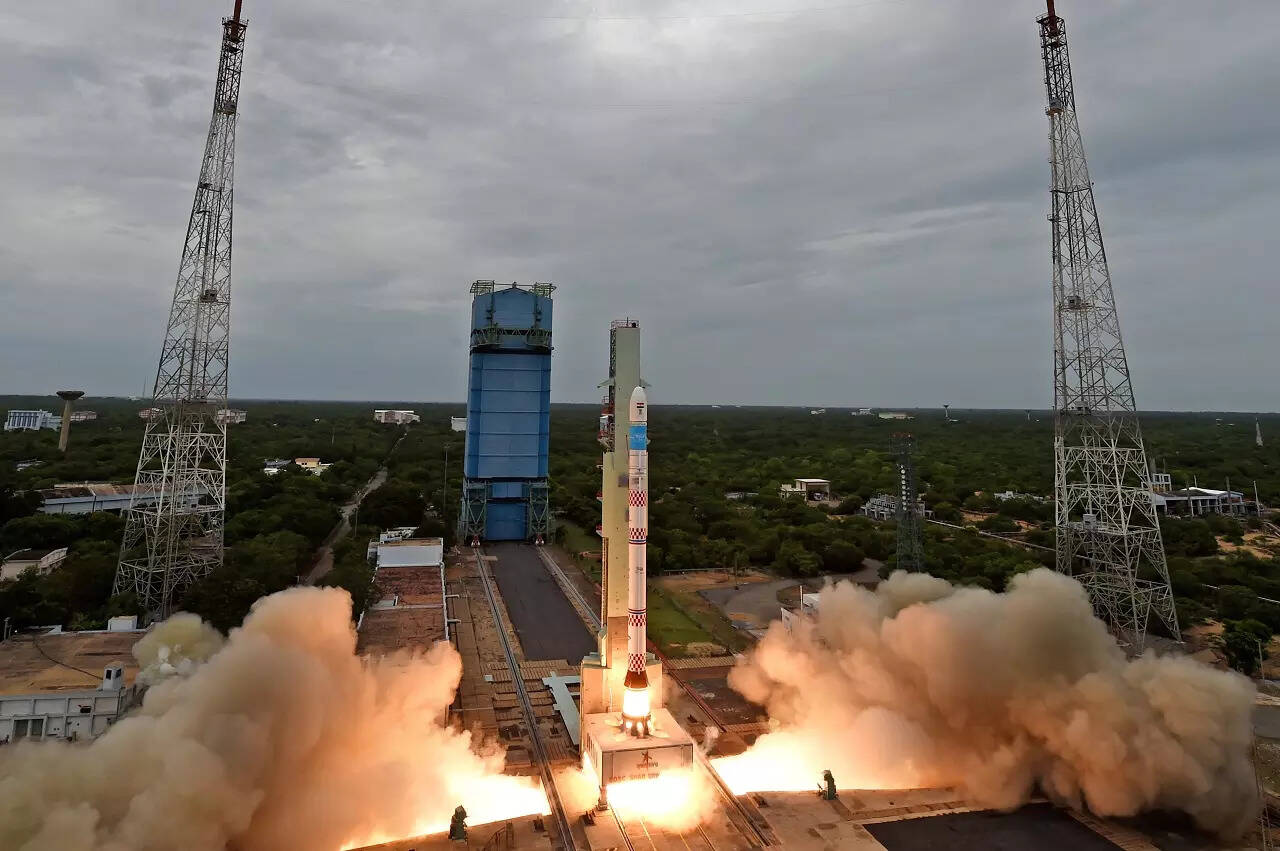BENGALURU: Isro on Wednesday said that the first developmental flight of the small satellite launch vehicle (SSLV-D1) mission could not be achieved on August 7, 2022, “due to an anomaly during the second stage (SS2) separation, which triggered a mission salvage mode — a procedure adopted to attempt minimum stabilised orbital conditions for the spacecraft in case of an anomaly in the vehicle system.
“A detailed analysis of the flight events and observations ranging from countdown, lift-off, propulsion performance, stage separations and satellite injection of SSLV-D1 revealed that there was a vibration disturbance for a short duration on the equipment bay (EB) deck during SS2 separation, that affected the inertial navigation system (INS), resulting in declaring the sensors faulty by the logic in fault detection & isolation (FDI) software,” the summary of the failure analysis committee (FAC) read.
The SSLV uses a newly developed INS — the MEMS (Micro-electromechanical systems) INS or MINS-6S — which consists of six MEMS gyros for measuring rotation rates and six ceramic servo accelerometers for measuring accelerations. The system is also designed with an in-built NavIC receiver and also acts as the MINS navigation computer processor for running inertial navigation and aided navigation software.
“A novel algorithm estimates the error in the orientation introduced due to the MEMS gyros, position and velocity of MEMS INS, using NavIC data and corrects them, so that mission accuracy is achieved. Knowing the health of accelerometers is paramount for the functioning of MINS, as it is used for orientation aiding. The failure detection logic identifies degraded accelerometers (one or all 6) and isolates the same for improved mission performance,” the summary read.
During the SS2 separation event, all six accelerometers experienced measurement saturation due to high vibration levels for a short duration, it added.
“The accelerometers got saturated at different time instants, within 20 millisecond (ms) interval of data sampling, which resulted in different acceleration values being measured by each sensor. This resulted in high residue values (difference among them) beyond a specified limit for a duration of 2-seconds. The software implementing FDI assessed that sensor outputs crossed pre-set threshold limit and raised alert for salvage mode initiation, which is a safety approach for mission,” it read.
However, accelerometers were found functioning well after this transient event. The salvage mission mode was fully executed without the support of accelerometer data and the satellite was injected to an unstable orbit due to lower injection velocity (around 56m/s less than the required 7,693 m/s).
“Though this is as programmed and expected, if kept observing for longer duration, the residue among the sensors would be within limit and failure logic would not have been executed,” the summary added.
Shock & Vibrations
The FAC added that vibrations were well within pre-flight test specifications except during SS2 separation when the EB and satellite interface had dominant vibration response.
“The shock response measured at EB during SS2 separation exceeded expectations and groundtest levels both in low and high frequency as well as in time duration. Due to this, excitation at MINS sensors was persistent for more than 10 millisecond (ms) which was not expected. It’s generally observed that shock from such events lasts for about 2ms,” the summary read.
Further, based on the flight telemetry data, all accelerometers were found functioning normally after the transient event till the end of the mission, indicating no damage to them.
“However, due to mission salvage setting by the FDI programme, data from accelerometers were not used for further mission execution,” it added.
Recommendations & Next Flight
The FAC has recommended corrections that include: Change of separation system; modification of MINS FDI logic; method of using NavIC data; keeping Velocity Trimming Module (VTM) in loop for salvage mode and design modification of EB and satellite assembly system along with VTM.
Isro said: “SSLV-D1 mission demonstrated satisfactory integrated performance of SSLV in all its systems including its flight through the aerodynamic regime, which is an accomplishment by itself. Considering clear identification of the cause of the flight anomaly and suggested corrective actions, the next development flight (SSLV-D2) is planned to be executed complying to recommendations, its satisfactory implementation, review and approval by the authorised committees.”
It added that the second developmental flight SSLV-D2 is scheduled in the first quarter of 2023 and will launch a total payload mass of about 334kg, including EOS-07 (an Earth observation satellite) and two co-passenger satellites.
“A detailed analysis of the flight events and observations ranging from countdown, lift-off, propulsion performance, stage separations and satellite injection of SSLV-D1 revealed that there was a vibration disturbance for a short duration on the equipment bay (EB) deck during SS2 separation, that affected the inertial navigation system (INS), resulting in declaring the sensors faulty by the logic in fault detection & isolation (FDI) software,” the summary of the failure analysis committee (FAC) read.
The SSLV uses a newly developed INS — the MEMS (Micro-electromechanical systems) INS or MINS-6S — which consists of six MEMS gyros for measuring rotation rates and six ceramic servo accelerometers for measuring accelerations. The system is also designed with an in-built NavIC receiver and also acts as the MINS navigation computer processor for running inertial navigation and aided navigation software.
“A novel algorithm estimates the error in the orientation introduced due to the MEMS gyros, position and velocity of MEMS INS, using NavIC data and corrects them, so that mission accuracy is achieved. Knowing the health of accelerometers is paramount for the functioning of MINS, as it is used for orientation aiding. The failure detection logic identifies degraded accelerometers (one or all 6) and isolates the same for improved mission performance,” the summary read.
During the SS2 separation event, all six accelerometers experienced measurement saturation due to high vibration levels for a short duration, it added.
“The accelerometers got saturated at different time instants, within 20 millisecond (ms) interval of data sampling, which resulted in different acceleration values being measured by each sensor. This resulted in high residue values (difference among them) beyond a specified limit for a duration of 2-seconds. The software implementing FDI assessed that sensor outputs crossed pre-set threshold limit and raised alert for salvage mode initiation, which is a safety approach for mission,” it read.
However, accelerometers were found functioning well after this transient event. The salvage mission mode was fully executed without the support of accelerometer data and the satellite was injected to an unstable orbit due to lower injection velocity (around 56m/s less than the required 7,693 m/s).
“Though this is as programmed and expected, if kept observing for longer duration, the residue among the sensors would be within limit and failure logic would not have been executed,” the summary added.
Shock & Vibrations
The FAC added that vibrations were well within pre-flight test specifications except during SS2 separation when the EB and satellite interface had dominant vibration response.
“The shock response measured at EB during SS2 separation exceeded expectations and groundtest levels both in low and high frequency as well as in time duration. Due to this, excitation at MINS sensors was persistent for more than 10 millisecond (ms) which was not expected. It’s generally observed that shock from such events lasts for about 2ms,” the summary read.
Further, based on the flight telemetry data, all accelerometers were found functioning normally after the transient event till the end of the mission, indicating no damage to them.
“However, due to mission salvage setting by the FDI programme, data from accelerometers were not used for further mission execution,” it added.
Recommendations & Next Flight
The FAC has recommended corrections that include: Change of separation system; modification of MINS FDI logic; method of using NavIC data; keeping Velocity Trimming Module (VTM) in loop for salvage mode and design modification of EB and satellite assembly system along with VTM.
Isro said: “SSLV-D1 mission demonstrated satisfactory integrated performance of SSLV in all its systems including its flight through the aerodynamic regime, which is an accomplishment by itself. Considering clear identification of the cause of the flight anomaly and suggested corrective actions, the next development flight (SSLV-D2) is planned to be executed complying to recommendations, its satisfactory implementation, review and approval by the authorised committees.”
It added that the second developmental flight SSLV-D2 is scheduled in the first quarter of 2023 and will launch a total payload mass of about 334kg, including EOS-07 (an Earth observation satellite) and two co-passenger satellites.


